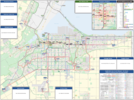I figure I'll provide some more of the juiciest details from the document. Starting off, to catch everyone up to speed this was the planned transit expansion framework for the HSR (and by extension, Metrolinx):
This was always fairly ambiguous on what these lines actually meant, but it was effectively a "priority corridors" map and a basic idea of where rapid transit corridors would/might go.
This has now been updated to the following:
Lots to go on about here. The current 5A, C, E, and 52's routes have been amalgamated in the map as the new 'T Line', acting as the western N/S route to travel the escarpment and reach Dundas.
At Mohawk, the T Line diverts from the old alignment and instead of going downtown, closes the N/S gap on the east Mountain at a new terminal. Here, the S Line and new (second) L Line meet.
The S Line now uses the Red Hill Valley Parkway to reach Parkdale Station, now interchanging with the new E Line and the modified T Line.
The B Line's bus extensions have been rearranged. With the new T Line going to Dundas, the B Line will instead go all the way to Winona rather than ending in Stoney Creek.
The old T and L Lines now compose the same, heavily interlined line going from Waterdown to downtown, Mohawk College, Limeridge, then back into the lower city via Kenilworth to Centre Mall at Barton (a great location for a future GO Station).






